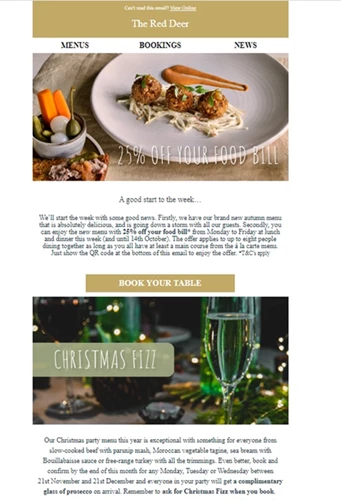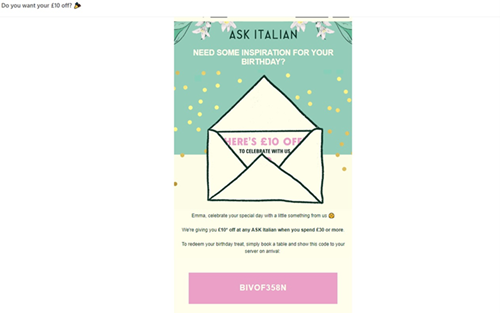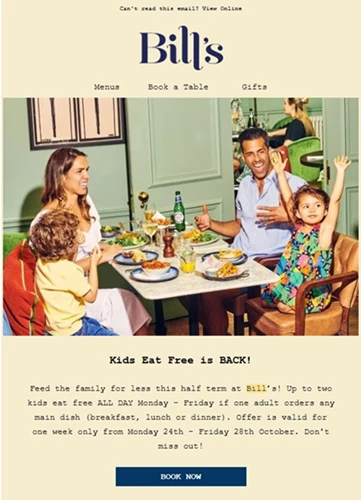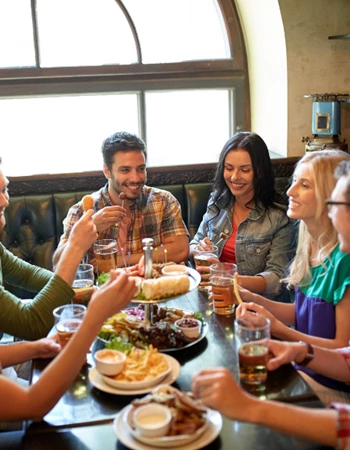-
- Solutions by business priority
- Boost efficiency and profitability
- End to end workforce management
- Attract customers and increase bookings

Best email marketing strategies and tips for restaurants
Many restauranteurs understand the value of a strong marketing strategy to help them attract new customers and ensure repeat business. In recent years email marketing has been used as part of that wider marketing strategy to help them reach their customers in a more direct and efficient way.
Email marketing can be highly effective for both independent and group restaurants, but if you’ve not yet used it, you might be wondering how it all works, or perhaps you are already using email marketing, but aren’t sure if you’ve maximised its potential.
As a leading supplier of CRM systems for restaurants, Access Hospitality is on hand to help restauranteurs of all types of restaurants gain a better understanding of restaurant email marketing and will offer its top tips to getting the most from it.
In this article, we’ll discuss why your restaurant should consider email marketing, what good email marketing involves and present some of the best restaurant email marketing examples so you can be ahead of the curve.
 10 mins
10 mins

Written by Jo Fontaine
Explore our guide to email marketing for restaurants
Why your restaurant should consider email marketing
Email marketing can be a powerful tool for restaurants, helping to bring new customers through your doors while also providing a chance to reconnect with previous customers and give them more reasons to re-visit. How much work is involved, though and what results can you expect?
According to Campaign Monitor, email marketing produces 174% more conversions than social media and costs less in time and effort than other forms of marketing. It is also a more reliable way to reach people than social media as you are using data you have collected to contact people directly. Algorithms and changing terms and conditions can make it hard for businesses to get what they need from social media.
Restaurants can also guarantee a strong return on investment (ROI). In Hubspot’s State of Inbound Marketing Trends 2022 report, research by Litmus shows that email marketing delivers a $36 return for every $1 spent.
There is also proof that a growing number of customers are responding to email marketing, making it a more effective means to reach them now and in the future. The same Hubspot report found that in 2021, 77% of marketers had seen an increase in email engagement over the last 12 months.
So what is it about email marketing that is fuelling these high rates of engagement and conversion?
There are a number of factors that could be behind this. Easy access to email inboxes from smartphones, alongside the traditional routes like laptops and PCs, means emails are more likely to be seen and read at a higher frequency.
And the fact that emails – thanks to a CRM system’s ability to segment and personalise data – can be made bespoke to each customer who has signed up to receive marketing messages, inevitably means there will be higher engagement and conversion. For example, a customer who is a parent might click through to book when sent an email with a ‘kids eat free’ offer while one without children is more likely to ignore, delete or even unsubscribe.
Benefits of email marketing for restaurants:
- Makes use of the data you own
- Provides strong marketing ROI
- Easily accessible for most customers
- Offers high levels of conversion
- Ability to personalise can improve brand loyalty
What does good email marketing for restaurants involve?
Restaurants can reap rewards by using email marketing, but there are a number of points to be aware of, and consider, before getting started to ensure you get the most out of it.
1. Install supportive technology. Quality technology software systems (e.g. online reservations systems, CRM and EPoS) that integrate and provide data will give you a strong framework to support your email marketing. If you’re in charge of a group of restaurants, you will want one with the flexibility to send out to all customers on the database if you’re running a group-wide promotion while also being able to only send to regulars of individual restaurants if it’s only relevant for certain sites.
2. Consult your marketing plan. This will help you understand who you want to reach, why you want to reach them and remind yourself of the essence of the brand. It is important to use the same brand tone throughout all communications, whether you’re sending an email, posting on social media or updating your website.
3. Streamline messaging. Before you compile any email marketing message, ensure your website is updated with the correct details, that your social media posts are in-step and staff at restaurants, or every site (if you’re a group) are aware of promotions to avoid potential confusion.
When you’ve sorted the basics, you can move on creating email marketing campaigns.
Here are our best email marketing top tips:
Have a clear strategy. If you’ve consulted your marketing plan you’ll have a clear understanding of what you want to achieve. Understanding this will help you formulate the rest.
Grow your customer list. The law of averages mean that the more people you are able to send marketing emails to, the better the results will be. Ensure you have an email opt-in on your restaurant’s website, on social media for passive searchers and at the point of booking for active users so you have as many people signed up as possible.
Segment your database. The most effective strategy for email marketing campaigns is subscriber segmentation, according Hubspot’s State of Inbound Marketing Trends 2022 report. This is used by 78% of marketers responding to the survey. Use your CRM to segment by different customer type (if you’ve grown your customer list as suggested, you’ll have lots to choose from) so you can target them appropriately.
Be GDPR compliant. As you are handling customer data collected via a website, you must be GDPR compliant under European rules introduced in 2018.
Choose email marketing software carefully. There are many systems on the market with a range of features. These might be the ability to create a bespoke template; tracking and analytic functions and automations. Maybe the software you’re already using at your restaurant has an email marketing function, so check this first and if it’s not offering what you want look into those that do. It can be a good idea to take the time to choose the right software for your needs and enable you benefit further down the line.
Include photography. People eat with their eyes and respond to images so when you’re in hospitality it’s a no-brainer to include shots of your delicious dishes, or your buzzing restaurant if you want to incentivise them to book.
Include a call to action. Once your message is complete and you’ve added it to your email marketing template, add a call to action, so those tempted by your offer can easily take advantage of your offer. Double check that links work or you could lose customers. According to Access Hospitality’s Hospitality Tech Shift Report, 65% of consumers are more likely to revisit a venue if they have a positive technology experience.
Top 5 restaurant email marketing strategies
Now you’re clear about where to start, we’ll take a deeper dive into some key strategies to employ in email marketing to help you get exactly what you need.
1. Personalisation
Personalisation through audience segmentation can drastically improve engagement with your email content. Message personalisation was listed as one of the most effective strategies for email marketing campaigns by 72% of marketers responding to Hubspot’s State of Inbound Marketing Trends 2022 report and personalised subject lines can increase open rates by up to 26% according to Campaign Monitor.
Personalising the content of your emails ensures that your email resonates with the values of the customer. And this extends to the promotions you use to drive visits to your restaurant. Everybody loves a promotion or discount, but when it isn’t relevant to the person you send it to, not only does it create disinterest in the offer but risks alienating customers who consider your venue as not ‘for them’.
Consider the impact of advertising your half-term ‘kids eat free’ promotion to customers without children – this content not only is an offer they are not going to make use of but also suggests that your venue is tailored to families and not the choice for an intimate dining experience with their partner or an adult-centred birthday celebration. In reality, your venue may well cater to both at different times, so it’s important to target the right audience segment with the right offer.
2. Segmentation
To personalise emails to your database, you’ll need to segment the data. Consider the following audience segments to create tailored, relevant promotions:
- Customers who have ordered online – deliver a future discount on an online order.
- Based on when they like to visit – midweek visitors might find a midweek deal of a free starter with any main course tempting.
- If customers have shown interest in a previous event, target them with similar events with a discount for early booking.
- Set up an automated birthday discount campaign that targets customers in the lead up to their birthday, so they are more likely to choose your venue to celebrate – this also avoids clogging up their inbox on their actual birthday when they likely have marketing offers from multiple companies.
- Target families with ‘kids eat free’ discounts and for events like Mother’s Day.
3. Build customer relationships
It’s easier and more cost-effective to drive repeat visits from your existing customers than to find new ones, so it’s important to build lasting customer relationships that will have people returning to your venue time and time again. And you can use your email marketing communications to build these ongoing relationships with the customers that have already expressed interest in your brand.
Customer loyalty programmes are an effective way to reward customer loyalty and can incentivise email list sign-ups. It is also possible to segment customers who have signed up to your loyalty programme to ensure you remain relevant to them when delivering new promotions, items and discounts through email.
You can also use your email programme to aid your ongoing reputation management efforts. Encouraging your customers to leave feedback after a visit will help you build a bank of online reviews to help encourage new customers to visit. Our recent research showed that 56% of consumers reported being deterred from visiting a venue if they couldn’t find reviews online in advance.
Consider how often your customers are likely to visit you. For many consumers, eating out is a treat and they may only visit sporadically or for special occasions. Your email communications can help you stay relevant in between visits, but you should consider a less sales-heavy approach. A newsletter that demonstrates your company’s values – sustainability practices, community influence and company updates, will help you stay in the mind of your less frequent customers, as well as communicate your other services – such as dine at-home kits or online ordering.
4. Turn new customers into regulars
Targeting your new customers after their first visit can be a very effective strategy in creating returning customers. You can segment and target this group of customers by considering how they found you. Groupon vouchers can be great for creating an uplift in new customers, but it can be difficult to convert these guests into repeat visitors but now you know they appreciated a discount, offering a return discount can be a good way to generate another visit.
If your venue hosts events like speed dating or wine tastings, this may be another route for customers with special interests to find your venue for the first time. You can then use this information to re-target them in the future with similar events or relevant offers. For example, your speed daters might appreciate a buy-one-get-one-free meal voucher for future dates.
But generally, your first-time customers might not know about everything you have to offer, so adding these customers to your email lists for communication allows you to showcase your various menus, promotions and company values.
5. Advertise special events, menus and offers
You can use your email marketing strategy to promote the special events, menus and offers you have that might interest your customer base and attract new ones. Creating a wide and varied calendar can help you encourage visits throughout the year and prevent lulls.
Look at your sales data to pinpoint where you could benefit from special promotions – are you generally quieter during the summer months? Maybe promote a refreshing summer cocktail menu. Struggling midweek? Think about having a weekly deal for a curry night or ‘Taco Tuesday’ regular promotion.
As well as the big calendar dates like Mother’s Day and Valentine’s Day, think about finding some fun days to celebrate that are relevant to your brand and menu, for example highlighting menu items on their special celebration day, such as Veganuary in January, British Pie Week in March and National Gin Day on 10 June. There are fun calendar dates for pretty much anything, and from a marketing perspective they provide a useful hook as there is less competition in your customer’s inbox for these dates.
Examples of effective email marketing
New menu promotion, week-dining discount and Christmas offer

Dining pub The Red Deer’s email delivers a hefty punch by highlighting its new autumn menu and then providing customers with an incentive to try it (in the form of a 25% discount). Note the offer is only valid Monday to Friday for lunch or dinner, therefore helping to fill it at traditionally quieter times, but it is highly tempting with photography of one of the new dishes and a link below to view the menu. The call to action ‘Book Your Table’ right under the promotion makes it easy for customers to redeem the deal.
The operator has also used the email to tell customers about another promotion – Christmas Fizz - providing further incentive to visit and helping the pub cement some early bookings for the festive season.
Personalised birthday incentive

Restaurant group ASK Italian maximises personalisation by addressing its email to the recipient and sending it just in time for their birthday. The email title ‘Do you want your £10 off?’ sounds like a generic offer but is strong enough to entice a click-through. The personalised ‘birthday treat’ available for four weeks around the recipient’s birthday makes them feel like the restaurant group values their custom, but the ‘inspiration’ angle gives them enough space to not feel pushed into booking.
Database segmentation reaches relevant customers

This simple communication from family-friendly restaurant chain Bill’s is sent out to a segmented database of those who have previously ordered from the children’s menu. The message is simple, direct and an effective promotion to bring families in during a specific timeframe. The photography is relevant and fun and the ‘book now’ button makes it quick and easy for customers to reserve a table and take advantage.
Tools and software that help email marketing
Good email marketing for restaurants requires supportive software. Here are some that will help:
CRM
A Customer Relationship Manager (CRM) platform is an essential tool to support your email marketing activity. This is where customer data is held and managed.
Some CRM systems also offer email marketing which can remove the need to source additional software.
Access Acteol can help you connect, segment, engage and measure your data through its Single Customer View, allowing you to use it in the most effective way and analyse the results of a campaign.
It also has a suite of functions, including the ability to automate the sending of email which can streamline the process and avoid sourcing additional email marketing software.
Online reservations system
As previously outlined, the purpose of email marketing could be to promote a special deal, tell customers about something new in your restaurant or just remind them you exist, but in all cases the communication is designed to draw customers into your restaurant.
Having a robust and reliable online reservations system in place before sending out any email marketing campaign is a must because it will make it easy for customers to book their space so they can join you during the promotional week or take advantage of the offer you’ve told them about.
Access Collins, our booking and reservations software, is designed for hospitality and manages every stage of the customer journey. Access Collins also allows restaurants to tailor the look and feel of email communication and the fact that email templates, menus and photos can be uploaded to one place means the process is quick and simple. Perfect for busy restaurants.
EPoS
The majority of restaurants already have an EPoS system in place, and it is the backbone of all technology systems used in the business.
An EPoS system can gather data relating to every customer visit, including ordering habits and allergen information which can help build a better picture of each customer and help with segmentation and personalisation of email marketing campaigns.
Choose an EPoS with the ability to integrate with other systems for a seamless experience - like our hospitality EPoS.
Email marketing
If your CRM system doesn’t allow templates to be created or support automation and you aren’t using a booking system with a marketing function, you’ll need to use email marketing software to reach your customers.
There are hundreds of these on the market, but some of the most popular ones include MailChimp and Sendinblue.
Your restaurant email marketing checklist
In this article, we’ve explored the best marketing strategies for restaurants and hospitality businesses and how you can implement them in your business.
Check out our email marketing checklist to help you get started with powerful email marketing campaigns:
- Software support. Check you have researched the systems required and have them in place before you devise your email marketing strategy. This will save you valuable time and money as you may already have some in place but aren’t using them to their full ability, or you may find you need to add or upgrade if not.
- Check your marketing strategy. Take a few moments to remind yourself of the wider plans to ensure an email marketing campaign supports them and is on-brand and on-message.
- Work your CRM. Make the most of the functions your customer relationship management system offers, including segmentation, automation and analytics, to really reap the benefits.
- Personalise. Customers love to feel special so make the most of segmentation and personalisation tools to encourage them to feel the love for your business.
- Think outside of the box. Be creative with your campaigns to make your email stand out in your customer’s inbox.
- Include a call to action. Make it easy for customers to find out more about the deal or book at table.
What next?
If you're interested in taking your restaurant's marketing strategy to the next level, email marketing and CRM tools can be a powerful way to engage with your customers and drive business growth.
If you want to learn more about email marketing or hospitality CRM, or if you want to see a demo of the tools in action, don't hesitate to reach out to us for more information and to help you determine if these tools are right for your restaurant.
Book a demo today and take the first step towards growing your business and connecting with your customers.
Find out more about our hospitality CRM, Acteol, and how it an help you achieve execute effective email marketing strategies
More about marketing
Related resources to support you in marketing your hospitality venue, attracting new customers and ensuring repeat business.









